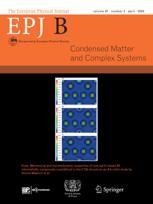Coalescence-fragmentation cycles based on Human conflict
Inspired by insurgency warfare dynamics, a model predicts patterns of how groups gel and shatter.
New York | Heidelberg, 17 April 2024
 In 1960, Lewis Fry Richardson famously observed that the severity of a wartime event is described by a simple power law distribution that scales according to the size of the conflict. Statisticians since have since proposed various modifications, but they continue to agree that casualty count in a violent conflict tends to scale with the size of the insurgent group that caused the conflict. In a study published in EPJ B, Brennen Fagan, of the University of York, UK, and his colleagues analyze models of how complex systems coalesce and fragment based on these warfare dynamics. Their work evaluates the robustness of these models and elucidates the relationship between microscopic dynamics and observed phenomena.
In 1960, Lewis Fry Richardson famously observed that the severity of a wartime event is described by a simple power law distribution that scales according to the size of the conflict. Statisticians since have since proposed various modifications, but they continue to agree that casualty count in a violent conflict tends to scale with the size of the insurgent group that caused the conflict. In a study published in EPJ B, Brennen Fagan, of the University of York, UK, and his colleagues analyze models of how complex systems coalesce and fragment based on these warfare dynamics. Their work evaluates the robustness of these models and elucidates the relationship between microscopic dynamics and observed phenomena.
In finite populations, groups coalesce and they fragment. These processes tend to balance one another, resulting in groups whose size distribution is described by a power law. Fagan surmised that these observed distributions result from the same basic self-organization that shapes human conflicts. Complex systems also feature finer-scale changes in group distributions: gelation, where most of the population is absorbed into a single large group; and shattering, where large groups break into individuals. Moreover, models suggest an emergent phenomenon: stochastic cycles of gelling and shattering.
Fagan and his colleagues performed simulations to examine how standard models of coalescence and fragmentation vary with different underlying or additional rules common to applications. They found that the basic power law distribution persisted when individuals moved to and from randomly-chosen groups, and with partial rather than total shattering. But for broader distributions of fragment sizes, the gel-shatter cyclicity no longer occurred.
The results should be applicable to a wide variety of systems, ranging from the physical interactions between asteroids and dust, to probabilistic, economic, biological, and social structures—such as the insurgent warfare that inspired the analysis.
Reference: Fagan, B.T., MacKay, N.J. & Wood, A.J. (2024), Robustness of steady state and stochastic cyclicity in generalized coalescence-fragmentation models. Eur. Phys. J. B 97:21 (2024). https://doi.org/10.1140/epjb/s10051-024-00654-y
Further Information
For more information visit: www.epj.org
Services for Journalists
The full-text article is available here.
Contact
Sabine Lehr | Springer | Physics Editorial Department
tel +49-6221-487-8336 | sabine.lehr@springer.com
